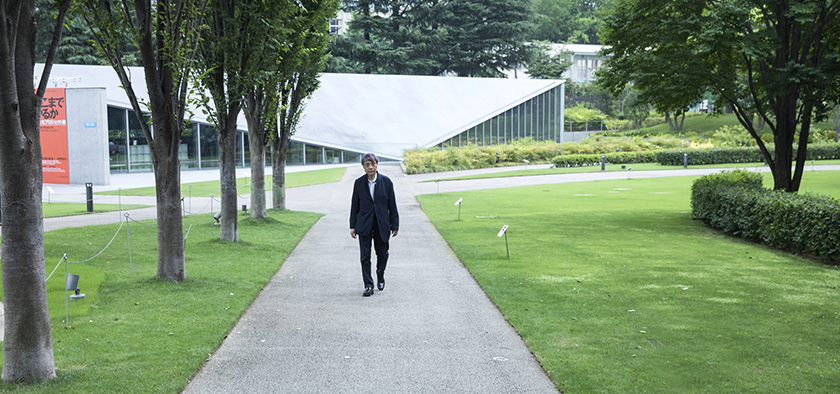
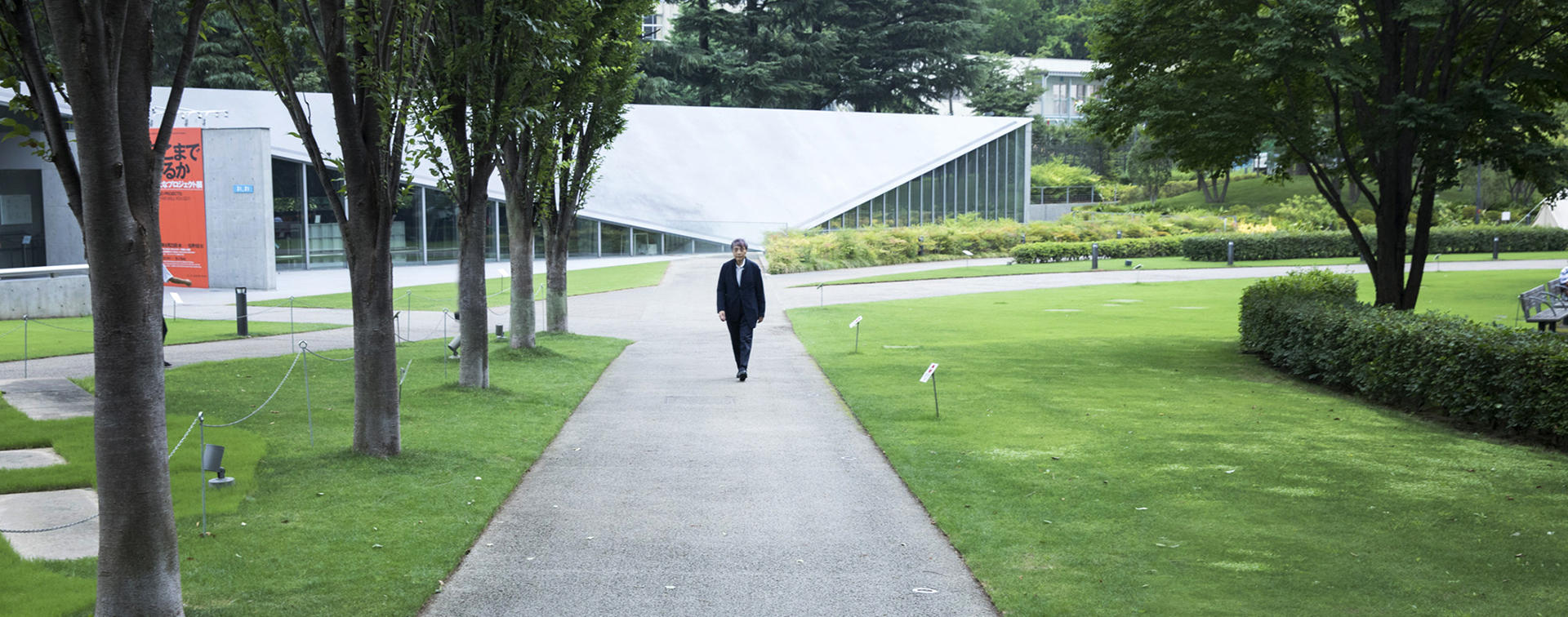
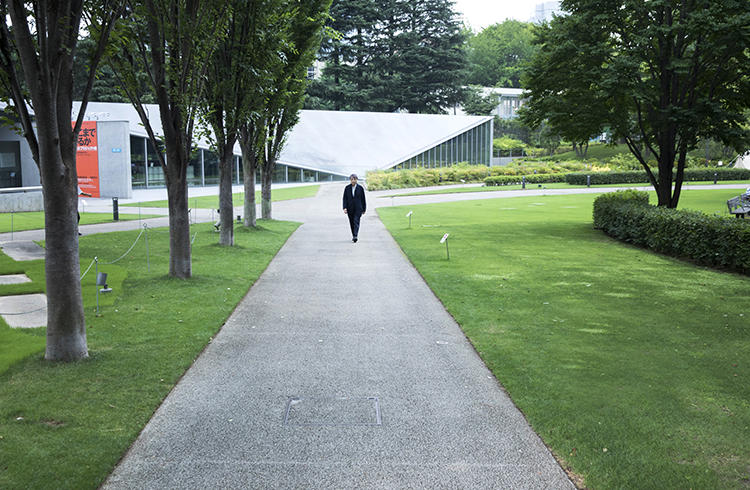
The appeal of buildings and cities are created by people
Things that are functional and rational are not necessarily good Bold steps need to be sometimes taken
Tadao Ando is world-renowned Japanese architect who continues to pursue the potential of architecture. Ando designed 21_21 DESIGN SIGHT and he has strong ties to Roppongi. This fall, the "Tadao Ando:Endeavors" exhibition will be held at the National Art Center, Tokyo. We asked him about his beginnings as an architect, his views on cities, and his suggestions for future society. It was an interview in which he gave us many thought-evoking and encouraging comments.
Staying fit to enjoy living in a house
There's a house called Row House in Sumiyoshi which I designed in 1976, and which in one respect, has a bad name. To go from the living room to the kitchen, you have to walk through the interior courtyard, and architecture critics say this makes the house inconvenient. In an age where modern buildings are praised if they are functional, rational and convenient, Row House in Sumiyoshi is not rational and has no continuity. If you are in the bedroom on the second floor and need to go to the toilet, and it happens to be raining, you must hold an umbrella. That certainly may not be convenient.
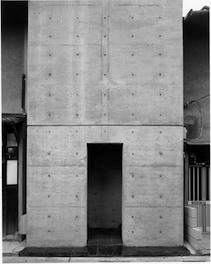
Row House in Sumiyoshi
A gem of a house completed in 1979. With exposed concrete walls, it was built on a limited budget on a small plot of land. The total ground-floor area was approximately 57 square meters, allowing for only two rooms on one floor. The interior courtyard comprises about a third of the ground-floor area and was made to comply with the ground coverage ratio requirements and also to let the wind and sunlight pass through.
1976, Osaka City, Osaka Prefecture (Photograph by the photography department at Shinkenchiku-sha Co.)
But the resident didn't think too badly of the house. The resident knows better than anyone that the interior courtyard allows the sunlight and wind to come through; the person has been living there after more than 40 years. The resident of Row House in Sumiyoshi and other people who asked me to design their homes seem to be enjoying living in the houses by staying resilient and physically fit.
I began my career as an architect by designing homes. Each home is different due to the environment of the place and the various requirements of the resident. There is a very human element in homes since they reflect the residents' thoughts and lifestyle.
Things that are functional and rational are not necessarily good. Condominiums which are standardized and uniformed may be convenient to live in, but they lack interestingness. A 3LDK (three rooms with a living, dining, kitchen area) in Tokyo is the same as a 3LDK in Osaka. How can it be interesting to live in a place that looks the same anywhere? The same thing can be said of cities.
Cities cannot be built only with economic efficiency in mind
In Japan, the business districts are filled with similar-looking square, box-shaped office buildings. These almost identical square buildings line the streets because they are efficient - they allow for easy calculation of profit and scheduling. Such buildings are really functional and rational, but a city cannot be built with only economic efficiency in mind. In a town where people are thinking about how much to pay for buying the land, how much to pay for making the building, and how much they would sell it for - in a city where everything is calculated like that - there is no place for people to just be themselves. We need to distance ourselves a little from calculations and do things that are different and drastic. Otherwise, cities, and our lives will not be interesting.
I think Roppongi is becoming a unique place. I'm particularly glad that the greenery was preserved in the area around 21_21 DESIGN SIGHT.
The "Tadao and Construction Site of 21_21: A Hard-Fought Process" exhibition will be held this fall at 21_21 DESIGN SIGHT. The basic plan for the building began in 2003. A proposal was made to build a cultural facility in a location that was a bit further away from the center of the Tokyo Midtown grounds. There were many skeptical views about building a facility in the corner. But the people in charge of development at Tokyo Midtown made the bold decision to go ahead with it. Their attitude was, "It's not a bad idea to have a low-rise building standing quietly in the middle of the trees on the edge of the compound." I laud their decision to implement the plan.
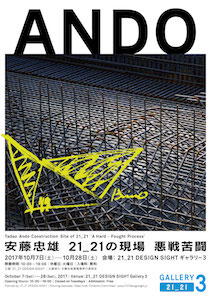
"Tadao and Construction Site of 21_21: A Hard-Fought Process" exhibition
An exhibition held in tandem with the "Tadao Ando:Endeavors" exhibition at the National Art Center, Tokyo. The process of designing and constructing the 21_21 DESIGN SIGHT will be shown. Visitors will be able to see how Ando has worked to make an appealing building for design while at the same time ensuring that that the environment of the surrounding space remains intact.
Roppongi has all the culture it needs
With city-themed projects, I have always sought to create empty spaces which do not have any specific function. The aim of these spaces is to encourage people to get together. With 21_21 DESIGN SIGHT, I wanted the facility to be Roppongi's empty space that people would become fond of. I wanted it to become a place of opportunities where people could try new things and transmit them.
The building expresses "a piece of cloth" which is a concept belonging to Issey Miyake-san who is one of the directors at 21_21 DESIGN SIGHT. Many technological challenges were made with the building, including having a single iron sheet as its roof. I think it is really fortunate that we were able to preserve the environment of this area.
Ten years have passed since the building's completion, and it looks nice, but I'm sure that in another ten years, the area here will become even better. They're taking proper care of the trees, and a fine forest is growing. It's thanks to the efforts of the people who use this place. A town takes shape through the thoughts and work of people; it would be wonderful if Roppongi could become an example of that.
I think that Roppongi has all the cultural facilities and cultural elements that it needs. It does not need anything new. All we need to do now is to think about how to use the things that exist. People who use the art museums and facilities need to come up with bold ideas for utilizing them.

Taking advantage of what already exists
Himalayan Cedars are lined up behind 21_21 DESIGN SIGHT; they were there before we began building the facility. People sometimes say, "The trees have been cleverly planted to look like a folding screen," but the Himalayan cedars were there from the beginning.
It's important in architecture, and in cities, to think about how you can take advantage of what already exists. At 21_21 DESIGN SIGHT, one of the existing assets was the Himalayan cedars. At Omotesando Hills, it was the boulevard of Japanese zelkova trees which are the symbols of Omotesando. To avoid the Omotesando Hills building becoming higher than the trees, we dug 30 meters underground and buried the building below ground level.
When you look at the rest of the world, you find that lively towns are those which have new places that pique people's curiosity and which blend in nicely with what already exists such as historical architecture and landscapes.
For example, there's the park in the sky in New York called the High Line. The park made use of an abandoned elevated freight rail line which stands about as high as a three-story building. With the renovation, a relaxing space with a lot of greenery has been created for the citizens. The Whitney Museum of American Art has relocated nearby, and the High Line is now New York's foremost cultural zone. The philosophy behind it and the way it has developed is interesting.
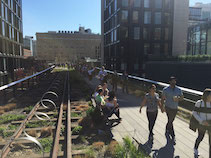
High Line
A linear park created on a disused railway line in Manhattan, New York. Converting the defunct elevated West Side Line of New York Central Railroad, the park was opened in 2009. The park has been gradually expanded, and the length of all three zones combined comes to more than 2 km.
http://www.thehighline.org/
Good things can happen when you keep persevering
A new challenge I am currently undertaking is the renovation of the 19th-century Bourse du Commerce (Commodities Exchange) into an art museum. The plan is to build an exhibition space made from reinforced concrete inside the dome roofed circular building. Since it is a renovation of a historical building, I'd imagined it would take about 10 years, but the people in Paris have worked hard, and it is scheduled to open in 2019.
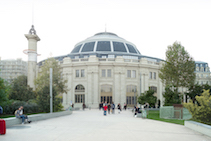
Bourse du Commerce (Commodities Exchange)
A building constructed in the 19th century for trade in grain and commodities. It is located in the central part of Paris, between the Louvre Museum and the Pompidou Center. It has been leased for 50 years to the Francois Pinault Foundation which is turning it into an art museum to display the foundation's collection of modern art. Tadao Ando's bold plan is to construct a concrete-walled structure within the historic building. A model of the planned museum will be shown at the "Tadao Ando:Endeavors" exhibition at the National Art Center, Tokyo.
Rendering of the facade from the jardin des Halles.© Artefactory Lab ; Tadao Ando Architect & Associates ; NeM / Niney & Marca Architectes ; Agence Pierre-Antoine Gatier. Courtesy Collection Pinault - Paris.
The client of this project is Mr. François Pinault who heads the Francois Pinault Foundation. About 15 years ago, I was involved with Mr. Pinault's plan to build a contemporary art museum on the Ile Seguin, an island on the River Seine. Construction began, but it was halted half-way; the location was changed to Venice in Italy, and we built the contemporary art museum Punta della Dogana.
In 2009, which was the year Punta della Dogana was completed, I had a huge operation to remove my gall bladder, bile duct and duodenum. In 2014, I had another big operation, this time to remove my pancreas and spleen. Both were major surgeries, but I went ahead with them with the attitude of, "Well, I'll just give this a try". The results were better than I expected and I have been energetically moving about since. I walk 10,000 steps every day; once a week I visit Tokyo from Osaka and once a month, I go abroad.
Mr. Pinault was concerned about my health, but one day when I was in Paris, I telephoned him and he said, "If you are in good health, there is something I would like you to do." That's how I became involved, once again, in a project in Paris. It was excellent timing. I hope that in the future, we will be able to hold an exhibition at the Pompidou Center in Paris.
In life, you cannot always walk on straight roads. You go this way or that way, and you sometimes take a few steps back when you thought you were going forward. Though I suppose the elite always move straight ahead. (laughs) Ordinary folk face all kinds of obstacles. But if you keep persevering, good things can happen.

There is potential in everyone
As an architect, my life has been a series of challenges. This is something I often talk about, but my first challenge was to teach myself architecture. I could not go to university or technical school because of economic reasons, but I had a strong desire to learn. Regardless of what people might say, you should pave your own path.
One of the things that I've learnt from architecture is that everyone has potential. Potential lies in each one of us. When you really know that, you can run in the dark. There are people who say they don't like the dark because you can't see ahead of you, but it's good to not know what lies ahead. To own your future which is not visible yet, you have to throw yourself single-mindedly into your work. There is no other way.
To work is a wonderful thing. When I was a child, our home was extended, and I saw a carpenter putting all his concentration into his work; watching him was what initially made me interested in architecture. I thought, "If an adult is so absorbed in this, architecture must surely be fascinating."
Working on one's own initiative
When thinking about the future of Japan, "work" is likely to become an increasingly important keyword. Japan does not have energy or food. The work people do is the only resources this country has. So we have to think seriously once more about working on one's initiative with hope and passion.
Until around the 1970s, if you could get high marks in exams and enter a prestigious university, it was possible to join a large corporation and have lifetime employment under a seniority-based system. But times have changed. I'm not saying that the seniority-based system and lifetime employment are bad, but now, even big companies can go bankrupt. That's why you should always keep in mind that you have to fend for yourself.
You have to pave your own path. You have to use your own mind to decide what needs to be done. This is particularly true for people who will become leaders in the future. I believe that people who can use their own minds are people who think can not only about themselves but also about other people.
Books I read in my twenties
In my early twenties, when I was aspiring to become an architect, one of the things I challenged myself to do was to read books. Like a student studying for the exams, I read about six hours a day, cutting down on sleep. In the 1960s, Kenzaburo Oe received the Akutagawa Prize, and Kobo Abe was getting attention for his works. I read their books, but to be honest, I wasn't able to understand them very well at that time. I would feel like giving up after reading the first five pages. But instead of giving up, I would read till the end. When I finished one book, I would buy another. And I kept doing that.
Among the books I read were Eiji Yoshikawa's "Miyamoto Musashi", and philosophical books by Tetsuro Watsuji and Kitaro Nishida. Tetsuro Watsuji's "Climate and Culture (Fudo)" and "Pilgrimages to the Ancient Temples in Nara (Koji Junrei)" had relevance on architecture, so I read them with interest, but I could not understand the writings of Kitaro Nishida at all. Looking back though, I'm glad I took the challenge of reading things beyond my grasp. Later, I was involved in building the Ishikawa Nishida Kitaro Museum of Philosophy, so it's a strange coincidence.
After turning 70 and undergoing big operations, I habitually rest for about an hour after lunch, spending the time reading. I often read books by Kenzaburo Oe and Kobo Abe which I could not understand when I was younger; it's interesting that now I understand them a little. Despite not comprehending them in my younger years, the time I spent reading was obviously not wasted - the books must have influenced me in some way.
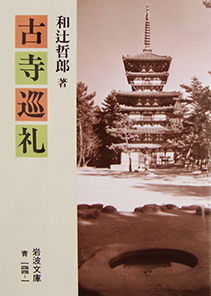
Tetsuro Watsuji's "Pilgrimages to the Ancient Temples in Nara (Koji Junrei)"
Written by the philosopher and intellectual historian Tetsuro Watsuji who wrote prolifically, this classic book contains Watsuji's thoughts on the temples in Nara which he visited in his 20s. Ando says that in his 20s, he traveled extensively to see the architecture of Japan, making frequent visits to Todaiji and Toshodaiji which deeply impressed him.
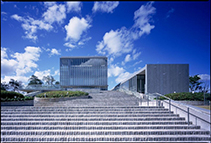
Ishikawa Nishida Kitaro Museum of Philosophy
A museum of philosophy in Kahoku City, Ishikawa Prefecture which is the birthplace of the famous Japanese philosopher Nishida Kitaro. Opened in 2002, the museum is themed on "contemplation" which is the foundation of philosophy. Visitors can contemplate while walking the maze-like structure inside the museum or in the foyer which is like a space for meditation. http://www.nishidatetsugakukan.org/
Uniqueness and the toughness to pave your own way
If asked which city I like, I would say "Osaka." It's a city which helped me to grow. As an architect, I've worked in countries around the world, but even now the sole headquarters of my office (Tadao Ando Architect & Associates) is in Osaka. It's unfortunate however, that Osaka is not popular...I feel that in the last 20 years in particular, the gap between Tokyo and Osaka has widened.
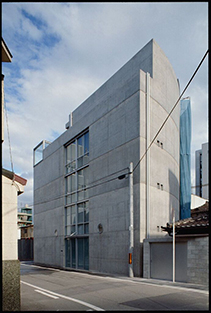
adao Ando Architect & Associates
Architectural office in Osaka which Ando Tadao set up in 1969 and which has been his headquarters since. The office is in a five-story building made of exposed concrete, and which had originally been designed to be a residence. Ando's desk is on the first floor which has a five-story ceiling. The Annex building standing opposite the office was also designed by Ando.
Sometimes, people seeking employment directly telephone our office. One of the things that have changed recently is that we get many calls from women who are interested in joining, but the fact that our only office is in Osaka presents difficulties. People who have graduated from a university in Tokyo are reluctant to go to Osaka to work. I think that the economic scale of Osaka is about a tenth of that of Tokyo, but the city is doing fairly well despite that. Osaka is praiseworthy. It's mostly made up of people who have been left behind, but they are putting up a good fight. (laughs) Whenever I give talks in Osaka, I always say this.
On the surface, Osaka is losing to Tokyo in terms of culture, but Osaka is unique. Uniqueness is a strong asset. Many of the people from Osaka are unique, aren't they? There's Muneaki Masuda-san of Culture Convenience Club and Hideo Sawada of H.I.S...Osaka people, including myself, all know that we have to pave our own paths. I think Osaka and its people are tough in that way.
Transporting the full-size replica of Church of the Light
Plans for the "Tadao Ando:Endeavors" exhibition at the National Art Center, Tokyo got underway because the director, Tamotsu Aoki-san offered me the opportunity, saying the exhibition would mark the tenth anniversary of the center. I wanted to do something bold to make the most of the opportunity and so I decided to display a full-size replica of Church of the Light. Architecture is about experience. I want visitors to directly experience the space. The entrance is about 6 meters wide, the length of the building is 18 meters and its height is about 8 meters; a replica of this church with exactly the same measurements has been placed outside. There were differing views about the definition of the replica, with some saying it's a building and others saying it would pass as an exhibition item. In the end, we applied for exhibition permission by confirming it as an "extended building."
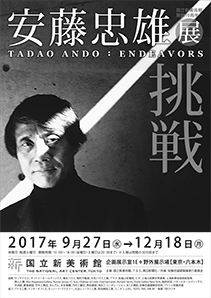
"Tadao Ando:Endeavors" exhibition
An exhibition to be held at the National Art Center, Tokyo to mark the center's 10th anniversary, it will be the largest ever exhibition of Tadao Ando's works. A wide variety of design drawings and images - including those of homes which were Ando's starting point - will be shown enabling the visitor to see how Ando's career has developed. Visitors will not want to miss the famous full-size replica of the Church of the Light to be exhibited outdoors.
Period: Sept.27-Dec.18, 2017
Venue: Special exhibition gallery 1E and open-air exhibition area at the National Art Center, Tokyo
http://www.tadao-ando.com/exhibition2017/
I'm hoping that in the future, we will be able to hold a similar exhibition at the Pompidou Center in Paris. Then this full-size replica of Church of the Light will have a place to go...The other day, I had a meal with Yoshiharu Ueki-san, president of Japan Airlines whom I met through an acquaintance; Ueki-san apparently used to be a pilot. Ueki-san told me, "We will transport anything." It just occurred to me now that Japan Airlines might be able to carry the Church of the Light to the Pompidou Center. (laughs)
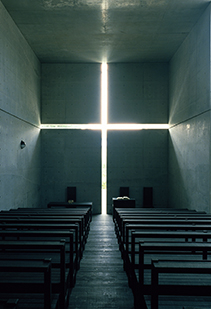
Church of the Light
(Photograph by Mitsuo Matsuoka)
A church built in Osaka's Ibaraki City in 1989 which is one of Ando's famous works. A full-size replica of this church will be shown at the "Tadao Ando:Endeavors" exhibition at the National Art Center, Tokyo, commemorating the center's 10th anniversary. The church is made up of a concrete cube with slits cut in the shape of a cross on one side. A wall penetrates part of the cube at an angle. The interior is extremely simple, and is bathed with the ever-changing light that passes through the cross-shaped slits.
To do something daring, it's vital to have an outstanding person on the team. You should always be alert to the encounters you make with people. That is one of the skills of getting through life. If there's a message I have for young people, it would be "Live skillfully." Use your own mind to think and take the initiative to acquire the necessary skills. I hope young people will skillfully live through the coming age.
Editor's thoughts
The interview was held at 21_21 DESIGN SIGHT. Ando-san arrived by himself looking full of energy. He talked spiritedly and laughed wholeheartedly, and when the interview was over, he walked briskly away to his next destination. I was impressed by his views that Roppongi does not need anything new, and all we need now is to come up with bold ideas for using what exists. Making a full-size replica of the Church of the Light was undoubtedly a bold idea. How lovely that we now have the chance to experience the masterpiece in Roppongi! I cannot wait to see it. (Tami Okano)
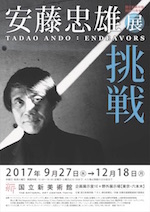
【information】
"Tadao Ando:Endeavors" exhibition
Period: Sept.27-Dec.18, 2017
Venue: Special exhibition gallery 1E and open-air exhibition area at the National Art Center, Tokyo
Closed: Every Tuesday
Opening hours: 10:00-18:00 (open until 20:00 on Fridays and Saturdays)
*Visitors must enter 30 minutes before closing time.
Telephone: 03-5777-8600 (Hello Dial)
Exhibition website: http://www.tadao-ando.com/exhibition2017/


















